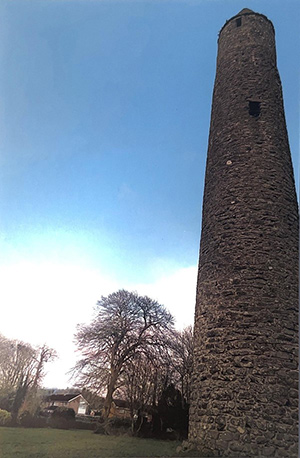Antrim’s Round Tower and Goban Saer
By Jessie Bolton, Antrim Grammar school
 Hundreds of people walk past Antrim’s Round Tower every day. It stands as a significant statement in the town’s skyline, watching over droves of children on their way to and from school. Truthfully, the tower is such an ordinary part of everyday life, that many forget the extraordinary history entrenched within its walls.
Hundreds of people walk past Antrim’s Round Tower every day. It stands as a significant statement in the town’s skyline, watching over droves of children on their way to and from school. Truthfully, the tower is such an ordinary part of everyday life, that many forget the extraordinary history entrenched within its walls.
The question remains: why does this matter? Even more importantly, why have we forgotten the answer to this question? Ask a select few, and they could fill hours with the tower’s exact details- from the walls which stand at an impressive twenty-eight metre stalls, to the extensive myths of witchcraft embedded in its soil. Instead, I invite you to focus on an aspect of the tower’s history which has been ignored for centuries: the tower’s forgotten architect.
Antrim’s Round Tower is undoubtedly an architectural masterpiece, frequently being described as ‘the finest of its kind’ when compared to the remaining twenty similar monuments across Ireland. However, its creator has been confined to the footnotes of history for over a millennium, despite being a pioneer in their field and a major contributor to the social, religious, and industrial history of the wider British Isles.
Debate shrouds the tower in history, yet many historians, most notably Dr George Petrie, concur that the tower was designed as early as the seventh century by prolific Irish architect Goban Saer. Petrie would continue in his life to win the prestigious Cunningham Medal from the Royal Irish Academy in 1831 for his essay entitled ‘Round Towers of Ireland’ and would dedicate his career to the topic. Perhaps surprisingly for the time, the Irish Miscellany of 1858 states that Saer was perceived as a woman in the northern parts of the island, where her most notable works are still situated today, including Antrim’s Round Tower.
Significantly, this isn’t a source from London, or Dublin, or even from Belfast. This is a source from a tiny town in County Antrim- a town omitted from the map of our national history. When the inhabitants of Antrim, Northern Ireland, look at their tower, they see much more than a memorial of a forgotten age. They see a woman who has contributed to every major industrial development in the country, centuries after her death. They see a woman who has paved the way for our thriving industrial culture. They see a woman who opened the door for Lady Margaret Perrie, the first president of Harland & Wolff Shipyards, critical in securing victory in the Battle of the Atlantic. They see a woman who was phenomenal, yet forgotten, and a place which is testament to her determination and skill.
An article published in the Kilmore Free Press on 13 April 1911 demonstrates how Saer was much more than merely an architect: she also adopted the roles of engineer and construction worker, with the lines between the positions much less defined than today. This is evidence that Saer is responsible for the tower’s success, and that she deserves wide-ranging credit in several sectors. Looking back from a time when women continue to be perpetually underestimated, it is vital that we recognise the work of a world-class woman endure millennia. Saer would go on to impact the international scene, with her architectural genius inspiring similar towers in Scotland and the Isle of Man. This is only one of many reasons why her work deserves to be immortalised in our history books.
Furthermore, Antrim’s Round Tower plays a fundamental role in the town’s history, marking the location of Antrim’s former monastery. Saer forged a monument central to the county’s thrilling past- surrounded by sieges, conflicts, and peril. Tragically, the monastery was burned to ruin in 1147, following a vicious Viking pillage. In fact, the threat was so great that Saer designed the tower as a watchpoint to forewarn future danger. However, this battle for territory on the island is omitted from our textbooks, forgotten in local schools. The tower is one of the only surviving monuments from the time- our only key to understanding this period of our past. We deserve the opportunity to comprehend our turbulent history, and that starts by studying the significance of our local landmarks.
However, the true importance of the tower will forever lie in its construction. The tower truly is a technical feat, having remained in pristine condition for a suspected 1400 years. This is a tribute to Saer’s extraordinary skill, as well as the traditional building methods of the time. A progressive system of pulleys and hoists was used to complete construction, highlighting the architect’s remarkable forward thinking.
 The tower’s influence extends throughout history and into the modern day. The community of Antrim has demonstrated its love for the tower for centuries, with large committees dedicating themselves to its conservation. When the roof of the tower was destroyed by a lightning strike in 1819, the local people drew together to replace it with its 1822 replica. This love for the tower continues to flourish in the modern age. Antrim and Newtownabbey Borough Council have released plans to develop the surrounding area into a seventeen-acre park for the community, showcasing the tower in all its glory, to share the tower’s incredible history with visitors from further afield.
The tower’s influence extends throughout history and into the modern day. The community of Antrim has demonstrated its love for the tower for centuries, with large committees dedicating themselves to its conservation. When the roof of the tower was destroyed by a lightning strike in 1819, the local people drew together to replace it with its 1822 replica. This love for the tower continues to flourish in the modern age. Antrim and Newtownabbey Borough Council have released plans to develop the surrounding area into a seventeen-acre park for the community, showcasing the tower in all its glory, to share the tower’s incredible history with visitors from further afield.
Today, the tower has evolved to soothe the scars of a fragmented nation. For the past two years, Antrim’s Round Tower has been bathed in emerald green on 17 March, celebrating St Patrick’s Day. This is a major milestone in the improvement of inter-faith and interdenominational relations in a country with a deeply secular past, proving the healing powers of history. Antrim’s Round Tower has matured, from a mere landmark, to become a symbol of the shoots of harmony in a previously divided community.
Over a millennium later, crowds still flock to admire Saer’s work. She inspired generations of architects and engineers (both men and women) and has built a legacy which has withstood lighting, fire, and time. The tower stands not only as an immortal symbol of Saer’s own ingenuity, but also as a reminder of the forgotten history of Northern Ireland.
This is why we need to recognise the significance of Antrim Round Tower. This is why we need to acknowledge what Saer contributed to our history, and to our future. This is why we must remember her name.

